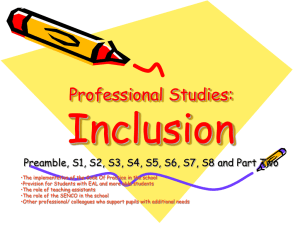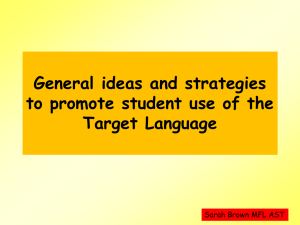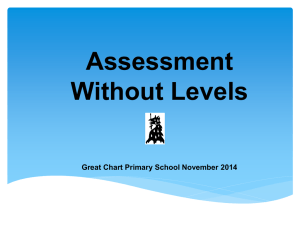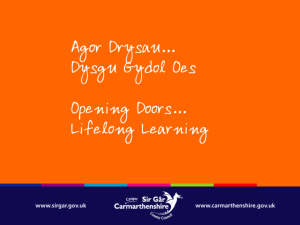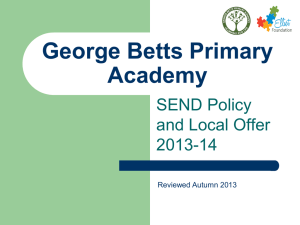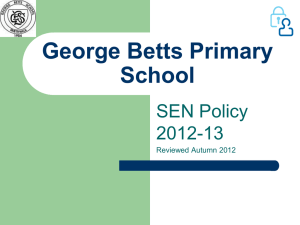Inclusion: Special Needs - Graduate School of Education
advertisement
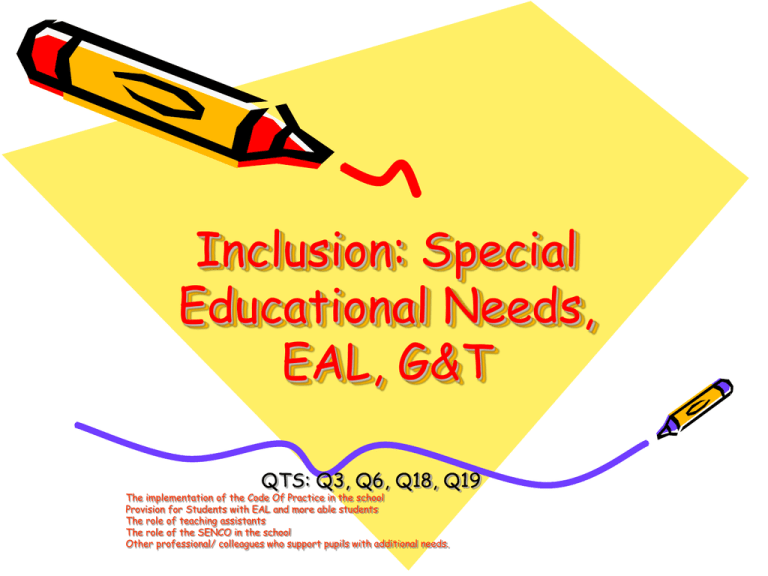
Inclusion: Special Educational Needs, EAL, G&T QTS: Q3, Q6, Q18, Q19 The implementation of the Code Of Practice in the school Provision for Students with EAL and more able students The role of teaching assistants The role of the SENCO in the school Other professional/ colleagues who support pupils with additional needs. SOUTH WEST INITIAL TEACHER EDUCATION PROFESSIONAL STUDIES PROGRAMME FOR SCHOOLS The people involved in the production of this presentation were: Claire Browne, Topsham School Sam Bone, Oldway Primary Charlotte Faulkner, Eggbuckland Primary Sally Eales, College of St Mark & St John Gini Wells, Littletown Primary Lynda King, University of Exeter IEP EAL SpLD G&T SENCo GEP ECM CAMHS Inclusion is…. • SEN, inc. physical disabilities and emotional, social and / or behavioural difficulties • EAL (Pupils with English as an Additional Language) • LAC (Children who are Looked After) • G & T (Gifted and Talented) • Pastoral (bereavement, transition, behaviour, self-esteem, attendance etc.) • Gender • MEG (Minority Ethnic Groups), inc. travellers, asylum seekers and refugees • other children, such as sick children; young carers; children from families under stress; children who are at risk of disaffection and exclusion from school; children from families of extreme poverty Every Child Matters • Safety & health • Pupil-performance and well-being go hand in hand • Every child to fulfil potential • Personalisation • Multi-professional approach • Pupil voice / pupil consultation / decision making • Empowering pupils to contribute to / evaluate own learning Every Child Matters so… Inclusion must be seen as the most effective route to learning for the greatest number of pupils by minimising barriers and maximising resources Introduction Special Educational Needs in all schools is governed by the Code of Practice. This underpins all SEN practice in schools, ensuring inclusion and equal entitlement for all. It considers: – Legalities – Entitlement – Provision What does this look like in school? Most schools take part in an exercise called Provision Mapping. This maps out the needs of each class / year group / the whole school, identifying groups, their needs and the level of support needed. Example What does this look like in school ? On provision maps, groups and individual pupils will be identified as needing Wave 1, 2 or 3 or Early Years / School Action, Early Years / School Action Plus and Statemented intervention and support. Pupils are then supported by an IEP, (Individual Education Plan) and GEP (Group Educational Plan). Terms explained! • Early Years / School Action - a pupil who is identified as having a specific weakness in an area, usually supported by good classroom differentiation and some intervention strategies • School Action Plus – as above with more focused intervention strategies, with the possibility of some withdrawal inputs. There might be some collaborative working with outside agencies • Statement - a pupil with an educational statement usually has a multitude of specific needs (e.g. medical, physical and learning difficulties), requiring dedicated funding and the possibility of 1:1 / small group TA support or a significantly differentiated curriculum Specific Needs Pupils might have one or more needs in any one of the following categories: • • • • Cognition and learning Behaviour, emotional and social development Communication and interaction Sensory and physical Usually the primary need is identified. Outside Agencies There are a range of agencies that are available to provide support and advice for schools, as well as specialist advice from local special schools. Within Devon/Torbay these include; CAMs- Children and Mental health BST- Behaviour support team S/L- Speech and Language EP- Educational Psychologist School Nurse Child and Family Guidance Why not try and research what other groups there are available in your area to support pupils learning in order to ensure total inclusion? Special Units To ensure inclusivity and integration some schools have specialized units to help support pupils in mainstream education. These can include: Hearing Impairment Autism Speech and Language Visual Impairment Roles in School Three crucial roles in school to support pupils with SEN needs: • Class teacher • Special Needs Coordinator (SENCO) • TA (Teaching Assistant) All working closely with the pupil and the family. SENCO This role varies between schools, but core principles are the same. This member of staff could be class based or non-class based, full time or part time depending on the schools needs and budget! • • • • • • • • Coordinate and compile paperwork, esp. IEPs and Annual Reviews Carry out any initial assessments Organise and facilitate use of SEN resources Oversee and monitor provision mapping Take part in the deployment of TAs Oversee dedicated teaching time for withdrawal groups Coordinate the use of intervention strategies Audit and provide / deliver CPD Is this a leadership route that would interest you? TA / HLTA This role has changed greatly in recent years. The role varies between schools but, in supporting pupils with SEN, they can be used to: – – – – – – – – – Deliver SEN intervention programmes Support learning directly within class Run social and communication groups, e.g. SEAL, SULP, THRIVE Work with specific individuals on individualised learning programmes Monitor and assess pupils learning Observe Liaise with parents Support transition But the class teacher Liaise with outside agencies maintains overall responsibility! Time To Share! • Look at the roles of SENCO, Class teacher and TA in supporting a child with SEN • How are these roles fulfilled in your current practice school? How is information shared? How are responsibilities / roles shared? Parents Parental involvement is crucial to ensuring SEN pupils are supported and make good progress and is outlined in the Code Of Pracice, e.g. • • • • • Research shows that parental involvement / interest in their child’s learning is an even more significant factor in success than intelligence Involvement in IEPS Review process Any referrals to outside agencies Regular liaison with class teacher, TA and SENCO Continuation of learning at home / consistent expectations Gifted and Talented Pupils • Gifted – highest achieving 10% in aspect(s) of core subjects • Talented – exceptional attainment in music, art, PE, interpersonal skills • Gifted and Talented • Dual Exceptionality • Gifted and Talented Coordinator (often SENCo) • National priority (Ofsted) Pupils with EAL • • • • • • • Termly assessments to LA Interventions / support Good classroom differentiation Consider parents’ / families’ needs Celebrate differences and own culture Dual language resources LA links / advice / support, e.g. translator ECM Registers Pupils do not fit neatly into distinct categories / labels. There are usually varying needs that need targeted support. Therefore, a personalised learning approach is key. Example Classroom Organisation Observation / Monitoring / Marking Target Setting Broad and balanced curriculum, inc. intervention strategies Differentiation Liaison with family Assessment Personalised Learning & Inclusion Learning Opportunity Use expertise through liaison with outside agencies and experts in school Enjoyment Teaching & Behaviour Management Class Teacher’s Responsibilities • Planning & Preparation • Teaching and range of teaching styles / techniques / strategies / pace • AfL • Pupil involvement / self-review • Pupil tracking • Monitoring progress • Effective record keeping • Differentiation / personalisation • Learning styles • Early identification of need • Early intervention • Use of all data available • Innovation and creativity – adapt curriculum Differentiation by… Which of these do you overuse? Underuse? Can you give an example where you differentiated well? How did you know? • Outcome • Support • Task • Dialogue • Resource • Pace Consideration of…. • Writing frames / wordbanks / writing equipment / ICT / writing slopes / enlarged texts & screens / other specialist equipment • Class layout and position in classroom • Learning breaks • Creative, flexible curriculum • Groupings / pairings • Range of task / resources / starting points • Flexible use of support An inclusive classroom with good teaching and learning has far-reaching effects for pupils other than those targeted. For example…… • • • • • • ‘Dyslexia-friendly’ classroom Effective management of physical space ‘Gift creation’ rather than gift identification Short, clear instructions Visual reminders Learning breaks Who does this benefit? • • • • • • • • Give clear instructions Sit by someone appropriate Give cues to stay on task – private signal Give frequent feedback on behaviour and redirect Chunk tasks Give breaks Work in a quiet place/remove distractions Give tasks one at a time


![afl_mat[1]](http://s2.studylib.net/store/data/005387843_1-8371eaaba182de7da429cb4369cd28fc-300x300.png)
